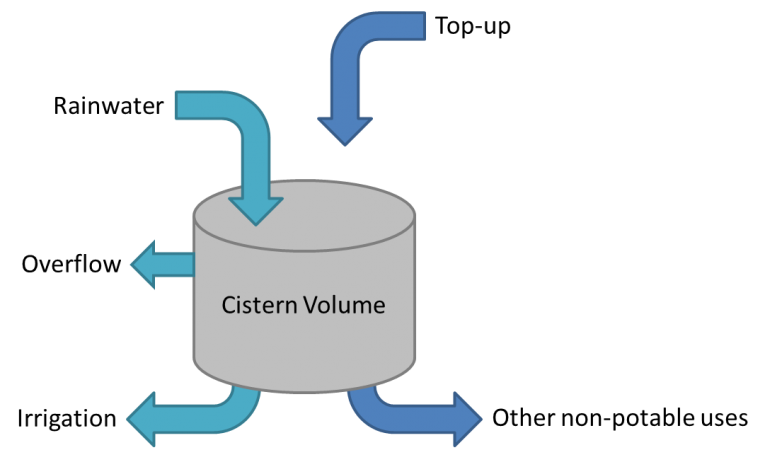Difference between revisions of "Rainwater harvesting: Sizing and modeling"
Jenny Hill (talk | contribs) |
Jenny Hill (talk | contribs) (→Rapid) |
||
| Line 2: | Line 2: | ||
{{TOClimit|2}} | {{TOClimit|2}} | ||
| − | ===Rapid=== | + | ====Rapid==== |
<p>Five percent of the average annual yield can be estimated: | <p>Five percent of the average annual yield can be estimated: | ||
<br><strong>Y<sub>0.05</sub>= A × C<sub>vol, A</sub> × R<sub>a</sub> × e × 0.05</strong> | <br><strong>Y<sub>0.05</sub>= A × C<sub>vol, A</sub> × R<sub>a</sub> × e × 0.05</strong> | ||
Revision as of 17:01, 1 August 2017
Rapid[edit]
Five percent of the average annual yield can be estimated:
Y0.05= A × Cvol, A × Ra × e × 0.05
Y0.05 = Five percent of the average annual yield (L)
A = The catchment area ( m2)
Cvol, A = The annual runoff coefficient for the catchment
Ra = The average annual rainfall depth (mm)
e = The efficiency of the pre-storage filter
- Filter efficiency (e) can be reasonably estimated as 0.9 pending manufacturer’s information.
- In a study of three sites in Ontario, STEP found the annual Cvol, A of the rooftops to be around 0.8 [1]. This figure includes losses to evaporation, snow being blown off the roof, and number of overflow events.
Five percent of the average annual demand (D0.05) can be estimated:
D0.05 = Pd × n × 18.25
D0.05 = Five percent of the average annual demand (L)
Pd = The daily demand per person (L)
n = The number of occupants
Then the following calculations are based upon two criteria:
- A design rainfall depth is to be captured entirely by the RWH system.
- The average annual demand (D) is greater than the average annual yield (Y) from the catchment.
When Y0.05/ D0.05 < 0.33, the storage volume required can be estimated:
VS = A × Cvol × Rd × e
VS = Storage volume required (L)
A = The catchment area (m2)
Cvol, E = The design storm runoff coefficient for the catchment
Rd = The design storm rainfall depth (mm), and
e = The efficiency of the pre-storage filter.
- Good catchment selection means that the runoff coefficient, for a rainstorm event (Cvol, E) should be 0.9 or greater.
When 0.33
< Y0.05/ D0.05
< 0.7, the total storage required can be estimated by adding Y0.05:
Total storage = VS + Y0.05
<panelInfo>
</panelInfo>
STEP Rainwater Harvesting Tool[edit]
The Sustainable Technologies Evaluation Program have produced a rainwater harvesting design and costing tool specific to Ontario. The tool is in a simple to use Excel format and is free to download.
The Treatment Train Tool[edit]
Once the size of cistern has been determined, it can easily be modelled in many open source and proprietary applications.
In addition to the cistern size, this watershed scale modelling requires input information about draw down time. i.e. the rate of use.
<btnPrimary>The Treatment Train Tool</btnPrimary>
- REDIRECT Special:ArticleFeedbackv5
